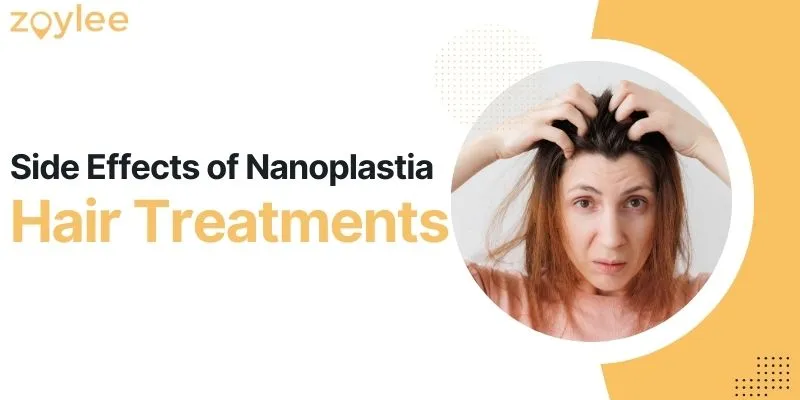Nanoplastia hair treatment has gained popularity for its promise of silky-smooth, frizz-free locks. While it’s generally safe and effective, it’s essential to be aware of potential side effects that may arise, as with any hair treatment. Understanding these side effects can help you make an informed decision and ensure a positive experience with Nanoplastia. In this comprehensive guide, we’ll delve into the possible side effects associated with Nanoplastia, empowering you to navigate your hair care journey with confidence and caution.
Scalp Irritation and Skin Sensitivity

This is the most common side effect, occurring in some individuals due to the presence of chemicals in the nanoplastia solution. It can manifest as:
- Redness
- Itching
- Rash
- Burning sensation
If you experience any of these symptoms, discontinue use immediately and consult a dermatologist or the stylist who performed the treatment.
Hair Damage or Breakage

While the treatment aims to improve hair health, improper application or excessive use of heat during the process can potentially damage hair, leading to:
- Dryness
- Brittleness
- Breakage
- Split ends
To minimize this risk, choose a qualified stylist with experience in Nanoplastia and follow their aftercare instructions carefully.
Allergic Reactions

Although rare, some individuals might be allergic to specific ingredients in the nanoplastia solution. It’s crucial to perform a patch test before the full treatment to check for potential allergic reactions.
Symptoms of an allergic reaction may include:
- Severe itching and redness of the scalp
- Scalp swelling
- Difficulty breathing
- Facial swelling
Alteration of Hair Texture
- Nanoplastia is designed to straighten and smooth hair. However, if you have naturally curly or coily hair, the treatment might alter your natural texture to a more relaxed or straighter form.
- Discuss your desired outcome thoroughly with your stylist before the treatment to ensure you understand the potential impact on your hair texture.
Excessive Dryness

In some cases, the treatment may leave hair feeling excessively dry, especially if your hair is already prone to dryness. This can be mitigated by:
- Using a hydrating deep conditioner regularly after the treatment.
- Opting for gentle, sulfate-free shampoos and conditioners.
- Using leave-in conditioners to provide additional moisture throughout the day.
Burns on the Scalp

Credit: advancedhairstudiouae
- This is a rare but potential side effect if the treatment is not applied correctly or if the heat is excessive during the process. It’s crucial to choose a qualified and experienced stylist to minimize this risk.
Important Guidelines Before Treatment:
- Individual experiences may vary: Not everyone experiences side effects, and the severity can differ based on individual factors like scalp sensitivity and hair type.
- Consult a professional: Discuss your concerns and hair history with a qualified stylist before undergoing the treatment. They can assess your suitability and advise on potential risks and benefits.
- Prioritize safety: Choose a reputable salon and experienced stylist who uses high-quality products and follows proper application techniques to minimize the risk of side effects.
Note: Women who use chemical hair straighteners and relaxers may have a higher risk of uterine cancer, according to a new study from researchers at the US National Institutes of Health (NIH)
Conclusion
While Nanoplastia hair treatment offers the allure of sleek, manageable hair, it’s crucial to recognize the potential side effects it may entail. From scalp irritation to alterations in hair texture, being informed about these possibilities is key to ensuring a safe and satisfying experience. By prioritizing safety, consulting with qualified professionals, and closely following aftercare instructions, you can mitigate the risk of adverse effects and enjoy the benefits of Nanoplastia with confidence. Remember, your hair health matters, so proceed with care and consideration for the best possible outcome.
FAQ’s:
Is Nanoplasty good for hair?
Yes, Nanoplastia is good for hair, offering the promise of smooth, frizz-free locks. However, like any hair treatment, it’s essential to consider potential side effects and individual suitability. Some possible side effects include scalp irritation, hair damage or breakage, allergic reactions, alteration of hair texture, excessive dryness, and even burns on the scalp.
Is Nanoplasty better than keratin?
The choice between Nanoplastia and keratin treatments depends on individual hair type and desired results. While Nanoplastia focuses on restructuring and straightening hair with the help of nanoparticles, keratin treatments primarily aim to smooth and strengthen hair using keratin protein.
Does Nanoplastia increase hair growth?
Nanoplastia treatments primarily focus on improving hair texture and appearance rather than stimulating hair growth.


